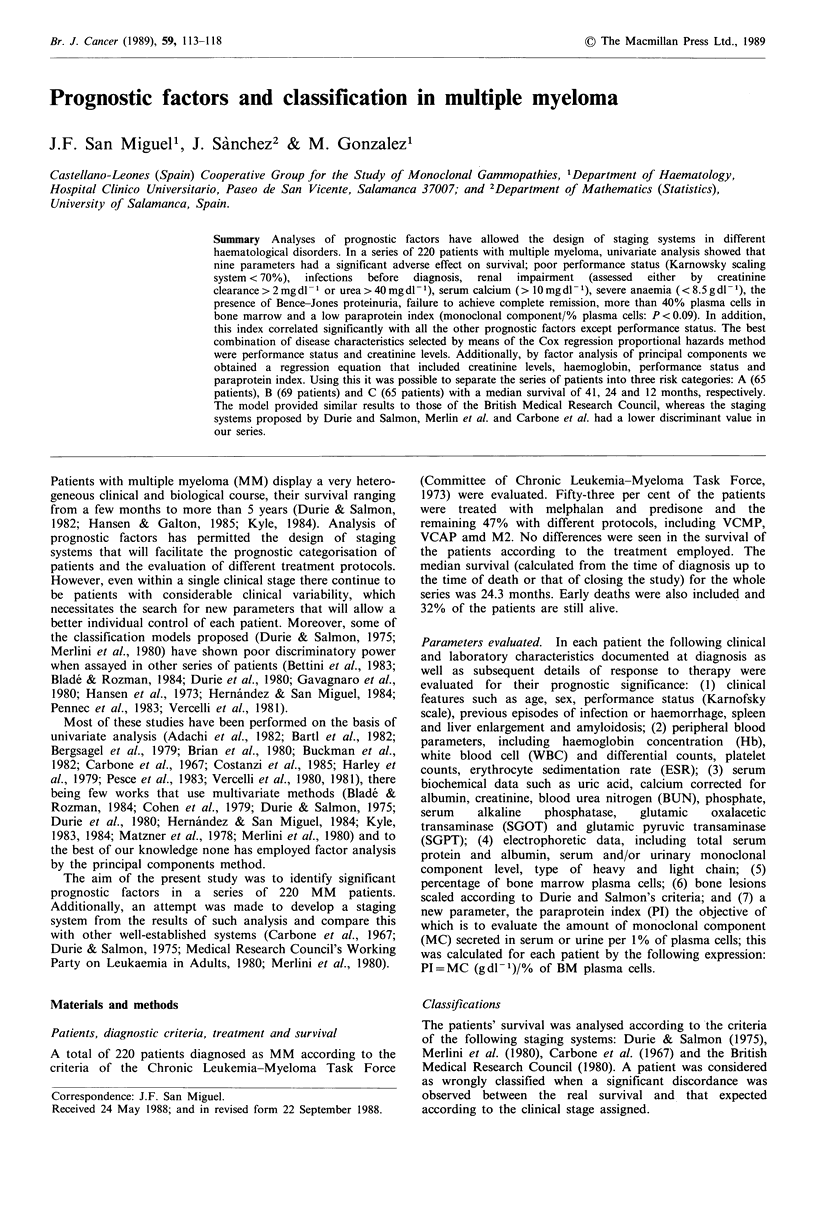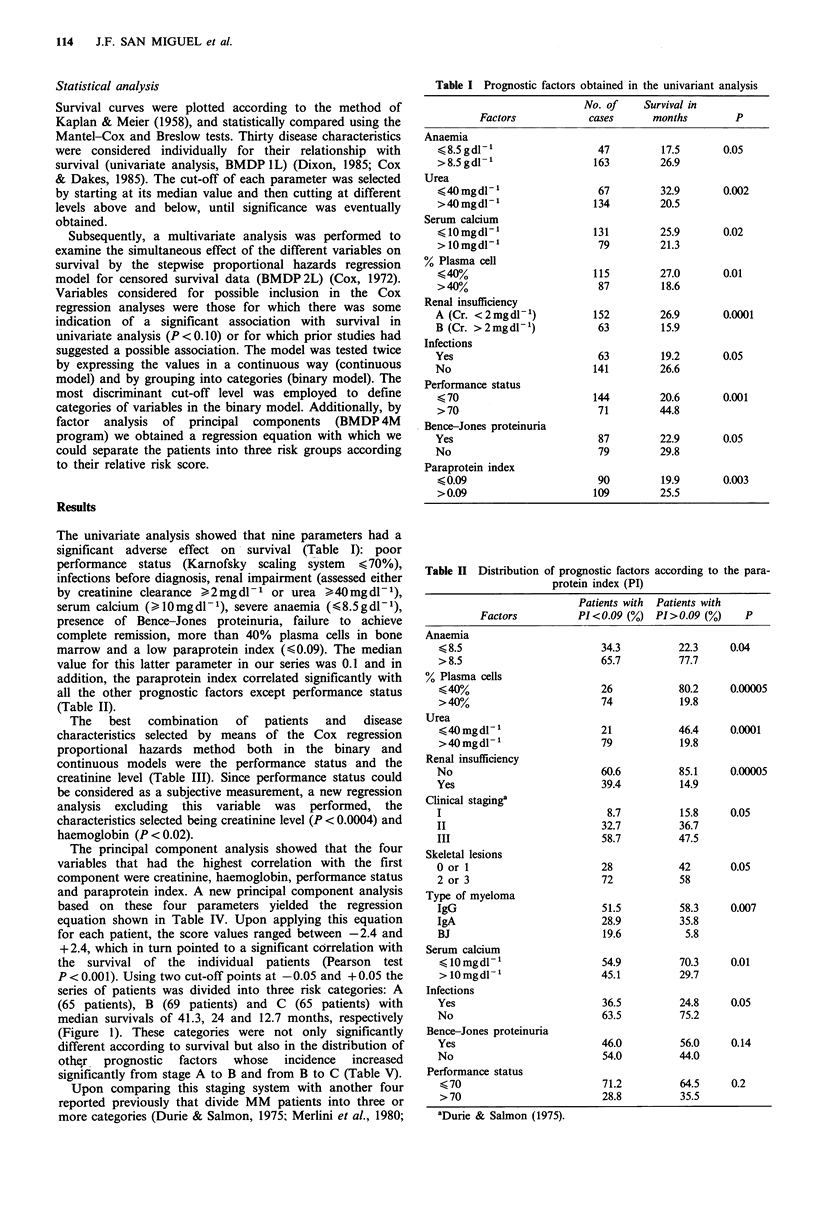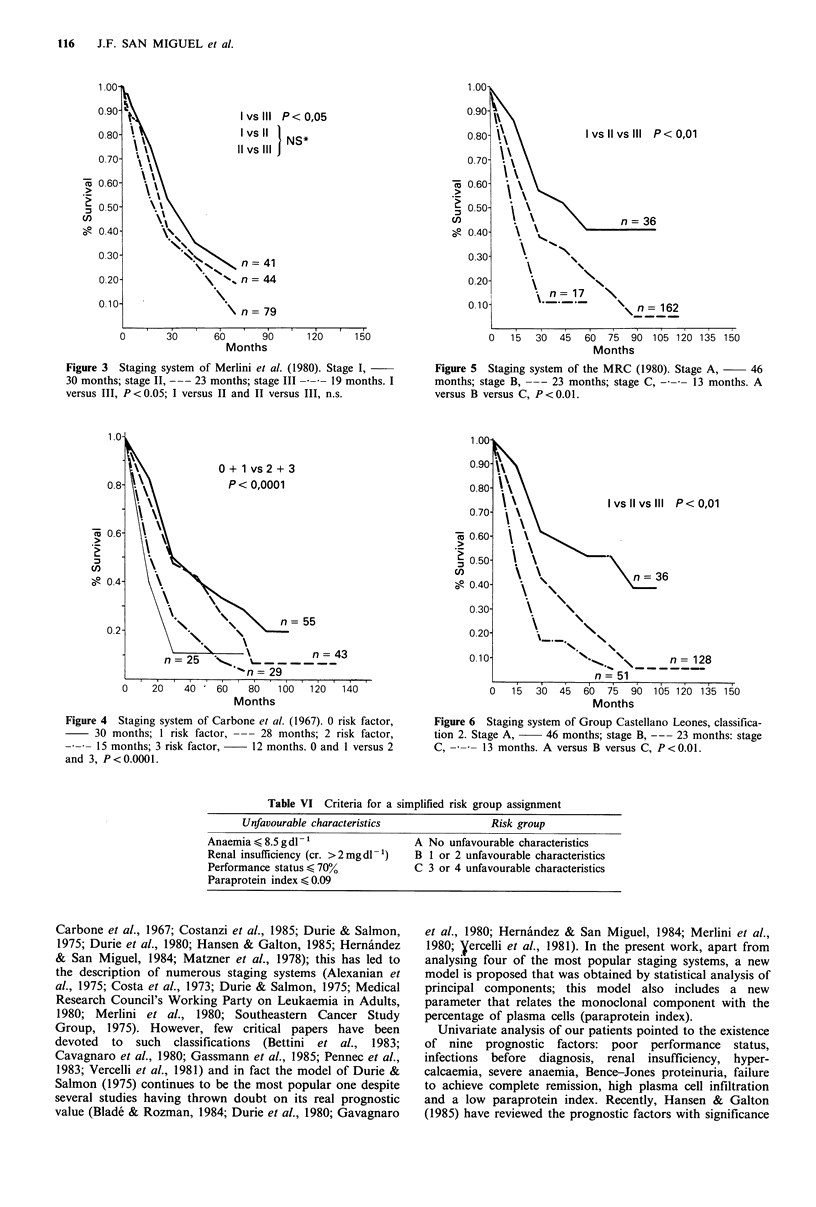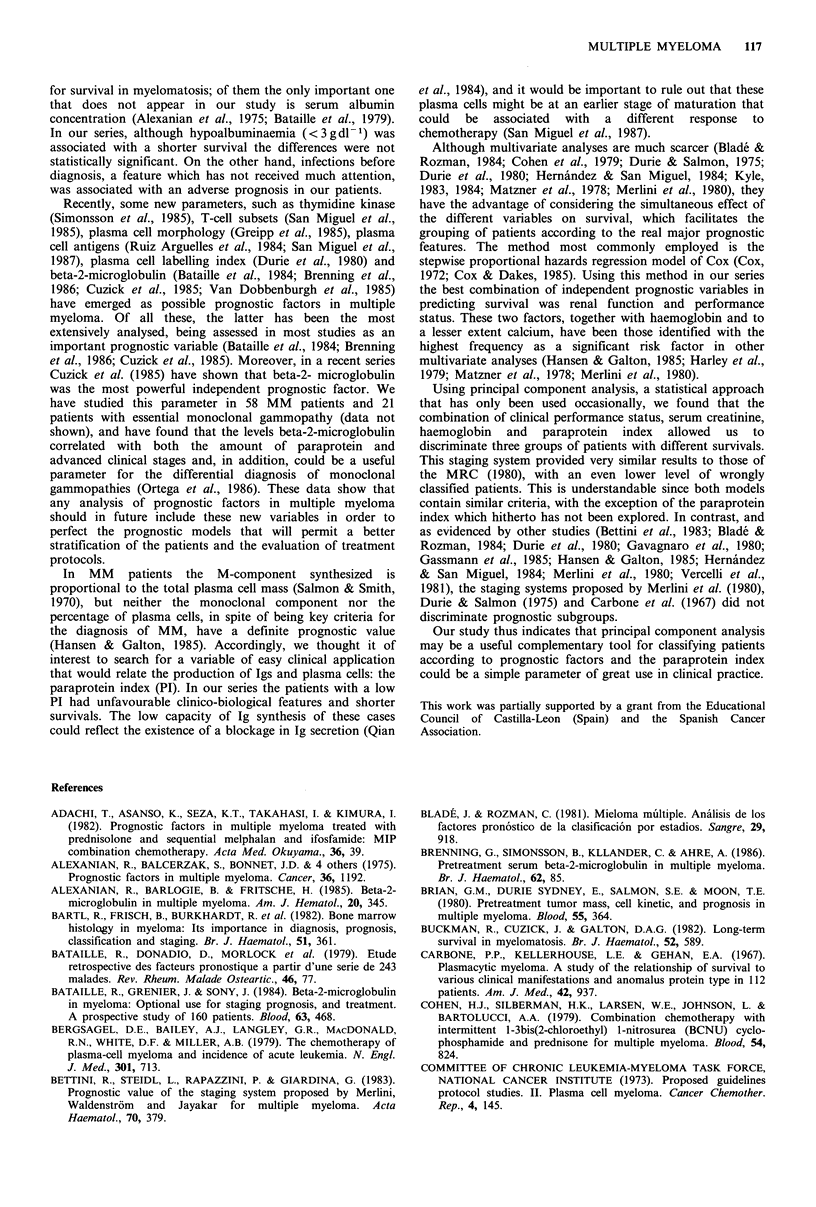Abstract
Analyses of prognostic factors have allowed the design of staging systems in different haematological disorders. In a series of 220 patients with multiple myeloma, univariate analysis showed that nine parameters had a significant adverse effect on survival; poor performance status (Karnowsky scaling system less than 70%), infections before diagnosis, renal impairment (assessed either by creatinine clearance greater than 2 mg dl-1 or urea greater than 40 mg dl-1), serum calcium (greater than 10 mg dl-1), severe anaemia (less than 8.5 g dl-1), the presence of Bence-Jones proteinuria, failure to achieve complete remission, more than 40% plasma cells in bone marrow and a low paraprotein index (monoclonal component/% plasma cells: P less than 0.09). In addition, this index correlated significantly with all the other prognostic factors except performance status. The best combination of disease characteristics selected by means of the Cox regression proportional hazards method were performance status and creatinine levels. Additionally, by factor analysis of principal components we obtained a regression equation that included creatinine levels, haemoglobin, performance status and paraprotein index. Using this it was possible to separate the series of patients into three risk categories: A (65 patients), B (69 patients) and C (65 patients) with a median survival of 41, 24 and 12 months, respectively. The model provided similar results to those of the British Medical Research Council, whereas the staging systems proposed by Durie and Salmon, Merlin et al. and Carbone et al. had a lower discriminant value in our series.
Full text
PDF





Selected References
These references are in PubMed. This may not be the complete list of references from this article.
- Adachi T., Asano K., Sezaki T., Takahashi I., Kimura I. Prognostic factors in multiple myeloma treated with prednisolone and sequential melphalan and ifosfamide: MIP combination chemotherapy. Acta Med Okayama. 1982 Feb;36(1):39–47. doi: 10.18926/AMO/30707. [DOI] [PubMed] [Google Scholar]
- Alexanian R., Balcerzak S., Bonnet J. D., Gehan E. A., Haut A., Hewlett J. S., Monto R. W. Prognostic factors in multiple myeloma. Cancer. 1975 Oct;36(4):1192–1201. doi: 10.1002/1097-0142(197510)36:4<1192::aid-cncr2820360403>3.0.co;2-i. [DOI] [PubMed] [Google Scholar]
- Alexanian R., Barlogie B., Fritsche H. Beta 2 microglobulin in multiple myeloma. Am J Hematol. 1985 Dec;20(4):345–351. doi: 10.1002/ajh.2830200405. [DOI] [PubMed] [Google Scholar]
- Bartl R., Frisch B., Burkhardt R., Fateh-Moghadam A., Mahl G., Gierster P., Sund M., Kettner G. Bone marrow histology in myeloma: its importance in diagnosis, prognosis, classification and staging. Br J Haematol. 1982 Jul;51(3):361–375. doi: 10.1111/j.1365-2141.1982.tb02791.x. [DOI] [PubMed] [Google Scholar]
- Bataille R., Grenier J., Sany J. Beta-2-microglobulin in myeloma: optimal use for staging, prognosis, and treatment--a prospective study of 160 patients. Blood. 1984 Feb;63(2):468–476. [PubMed] [Google Scholar]
- Bettini R., Steidl L., Rapazzini P., Giardina G. Prognostic value of the staging system proposed by Merlini, Waldenström and Jayakar for multiple myeloma. Acta Haematol. 1983;70(6):379–385. doi: 10.1159/000206796. [DOI] [PubMed] [Google Scholar]
- Bladé J., Rozman C. Mieloma múltiple: análisis de los factores pronósticos y de la clasificación por estadios. Sangre (Barc) 1984;29(5):918–926. [PubMed] [Google Scholar]
- Brenning G., Simonsson B., Källander C., Ahre A. Pretreatment serum beta 2-microglobulin in multiple myeloma. Br J Haematol. 1986 Jan;62(1):85–93. doi: 10.1111/j.1365-2141.1986.tb02903.x. [DOI] [PubMed] [Google Scholar]
- Buckman R., Cuzick J., Galton D. A. Long-term survival in myelomatosis. A report to the MRC working party on leukaemia in adults. Br J Haematol. 1982 Dec;52(4):589–599. doi: 10.1111/j.1365-2141.1982.tb03935.x. [DOI] [PubMed] [Google Scholar]
- Carbone P. P., Kellerhouse L. E., Gehan E. A. Plasmacytic myeloma. A study of the relationship of survival to various clinical manifestations and anomalous protein type in 112 patients. Am J Med. 1967 Jun;42(6):937–948. doi: 10.1016/0002-9343(67)90074-5. [DOI] [PubMed] [Google Scholar]
- Cavagnaro F., Lein J. M., Pavlovsky S., Becherini J. O., Pileggi J. E., Micheo E. Q., Jait C., Musso A., Suárez A., Pizzolato M. Comparison of two combination chemotherapy regimens for multiple myeloma: methyl-CCNU, cyclophosphamide, and prednisone versus melphalan and prednisone. Cancer Treat Rep. 1980 Jan;64(1):73–79. [PubMed] [Google Scholar]
- Cohen H. J., Silberman H. R., Larsen W. E., Johnson L., Bartolucci A. A., Durant J. R. Combination chemotherapy with intermittent 1-3-bis(2-chloroethyl)1-nitrosourea (BCNU), cyclophosphamide, and prednisone for multiple myeloma. Blood. 1979 Oct;54(4):824–836. [PubMed] [Google Scholar]
- Costanzi J. J., Cooper M. R., Scarffe J. H., Ozer H., Grubbs S. S., Ferraresi R. W., Pollard R. B., Spiegel R. J. Phase II study of recombinant alpha-2 interferon in resistant multiple myeloma. J Clin Oncol. 1985 May;3(5):654–659. doi: 10.1200/JCO.1985.3.5.654. [DOI] [PubMed] [Google Scholar]
- Cuzick J., Cooper E. H., MacLennan I. C. The prognostic value of serum beta 2 microglobulin compared with other presentation features in myelomatosis. Br J Cancer. 1985 Jul;52(1):1–6. doi: 10.1038/bjc.1985.140. [DOI] [PMC free article] [PubMed] [Google Scholar]
- Durie B. G., Salmon S. E., Moon T. E. Pretreatment tumor mass, cell kinetics, and prognosis in multiple myeloma. Blood. 1980 Mar;55(3):364–372. [PubMed] [Google Scholar]
- Durie B. G., Salmon S. E., Moon T. E. Pretreatment tumor mass, cell kinetics, and prognosis in multiple myeloma. Blood. 1980 Mar;55(3):364–372. [PubMed] [Google Scholar]
- Durie B. G., Salmon S. E. The current status and future prospects of treatment for multiple myeloma. Clin Haematol. 1982 Feb;11(1):181–210. [PubMed] [Google Scholar]
- Gassmann W., Pralle H., Haferlach T., Pandurevic S., Graubner M., Schmitz N., Löffler H. Staging systems for multiple myeloma: a comparison. Br J Haematol. 1985 Apr;59(4):703–711. doi: 10.1111/j.1365-2141.1985.tb07366.x. [DOI] [PubMed] [Google Scholar]
- Greipp P. R., Raymond N. M., Kyle R. A., O'Fallon W. M. Multiple myeloma: significance of plasmablastic subtype in morphological classification. Blood. 1985 Feb;65(2):305–310. [PubMed] [Google Scholar]
- Hansen O. P., Galton D. A. Classification and prognostic variables in myelomatosis. Scand J Haematol. 1985 Jul;35(1):10–19. doi: 10.1111/j.1600-0609.1985.tb00792.x. [DOI] [PubMed] [Google Scholar]
- Hansen O. P., Jessen B., Videbaek A. Prognosis of myelomatosis on treatment with prednisone and cytostatics. Scand J Haematol. 1973;10(4):282–290. doi: 10.1111/j.1600-0609.1973.tb00073.x. [DOI] [PubMed] [Google Scholar]
- Hernández J. M., San Miguel J. F. Factores de pronóstico y estadios en mieloma múltiple. Sangre (Barc) 1984;29(5):927–935. [PubMed] [Google Scholar]
- Kyle R. A. Long-term survival in multiple myeloma. N Engl J Med. 1983 Feb 10;308(6):314–316. doi: 10.1056/NEJM198302103080604. [DOI] [PubMed] [Google Scholar]
- Kyle R. A. Treatment of multiple myeloma. A small step forward? N Engl J Med. 1984 May 24;310(21):1382–1384. doi: 10.1056/NEJM198405243102109. [DOI] [PubMed] [Google Scholar]
- Matzner Y., Benbassat J., Polliack A. Prognostic factors in multiple myeloma: a retrospective study using conventional statistical methods and a computer program. Acta Haematol. 1978;60(5):257–268. doi: 10.1159/000207722. [DOI] [PubMed] [Google Scholar]
- Merlini G., Waldenström J. G., Jayakar S. D. A new improved clinical staging system for multiple myeloma based on analysis of 123 treated patients. Blood. 1980 Jun;55(6):1011–1019. [PubMed] [Google Scholar]
- Pesce A., Cassuto J. P., Grisot C., Gratecos N., Bayle J., Viot G., Dujardin P. Etude comparée de deux classifications pronostiques du myélome et recherche d'une corrélation entre la plasmocytose médullaire initiale et le pronostic. A propos d'une population homogène de 50 malades suivis du diagnostic au décès. Nouv Rev Fr Hematol. 1983;25(5):311–317. [PubMed] [Google Scholar]
- Qian G. X., Fu S. M., Solanki D. L., Rai K. R. Circulating monoclonal IgM proteins in B cell chronic lymphocytic leukemia: their identification, characterization and relationship to membrane IgM. J Immunol. 1984 Dec;133(6):3396–3400. [PubMed] [Google Scholar]
- Ruiz-Argüelles G. J., Katzmann J. A., Greipp P. R., Gonchoroff N. J., Garton J. P., Kyle R. A. Multiple myeloma: circulating lymphocytes that express plasma cell antigens. Blood. 1984 Aug;64(2):352–356. [PubMed] [Google Scholar]
- San Miguel J. F., Moro M. J., Gonzalez M. Plasmablastic multiple myeloma: an immunologically different subtype. Br J Haematol. 1987 Jun;66(2):275–275. doi: 10.1111/j.1365-2141.1987.tb01312.x. [DOI] [PubMed] [Google Scholar]
- Simonsson B., Källander C. F., Brenning G., Killander A., Ahre A., Gronowitz J. S. Evaluation of serum deoxythymidine kinase as a marker in multiple myeloma. Br J Haematol. 1985 Oct;61(2):215–224. doi: 10.1111/j.1365-2141.1985.tb02820.x. [DOI] [PubMed] [Google Scholar]
- Vercelli D., Cozzolino F., Di Guglielmo R. A comparison of two staging systems for myeloma. Nouv Rev Fr Hematol. 1981;23(2):107–110. [PubMed] [Google Scholar]
- Vercelli D., Di Guglielmo R., Guidi G., Scolari L., Buricchi L., Cozzolino F. Bone marrow percentage of plasma cells in the staging of monoclonal gammopathies. Nouv Rev Fr Hematol. 1980;22(2):139–145. [PubMed] [Google Scholar]
- van Dobbenburgh O. A., Rodenhuis S., Ockhuizen T., Weltevreden E., Houwen B., Fidler V., Meijer S., Marrink J. Serum beta 2-microglobulin: a real improvement in the management of multiple myeloma? Br J Haematol. 1985 Dec;61(4):611–620. doi: 10.1111/j.1365-2141.1985.tb02874.x. [DOI] [PubMed] [Google Scholar]


